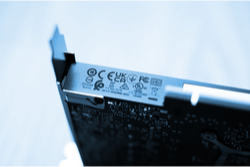 From children’s toys to medical devices, a close look at all kinds of products will reveal a series of familiar (and possibly not so familiar) markings.
From children’s toys to medical devices, a close look at all kinds of products will reveal a series of familiar (and possibly not so familiar) markings.
Several of these product markings – including the CE mark, UKCA mark and UKNI mark – are often mandatory, and used to demonstrate that a product or service meets legal requirements. Others – like the BSI Kitemark™ – are voluntary, and used to inspire trust and confidence by demonstrating a level of quality, safety, sustainability, and/or security, over and above any basic legal requirements.
But, with changes to UK and European marking systems coming into effect post-Brexit, how well do you know your markings, what they are used for, and how they can be used to maintain market access and inspire confidence in your products?
Here we explore the recent changes to product markings, and how optional markings like the BSI Kitemark™ can be used to differentiate your organisation with a hallmark of exceptional quality.
Mandatory product markings:
CE mark
What is it?
The CE mark proves that a product meets minimum legal safety, health, and environmental protection requirements to be placed on the market within any EU member state. The product can be manufactured anywhere in the world, but if it is a product that falls under EU law, for example a medical device, it must carry this mark to be sold within the European Union.
From the 1st January 2023, CE Marking will no longer be accepted on most new products placed on the market in Great Britain and UKCA will be required. UKCA will not be recognised in the EU market. Products that previously required a CE marking will still need a CE marking to be sold in the EU.
For products required to be tested according to UK/EU regulations, the number of the Notified Body or Approved Body doing the testing should follow the mark (for BSI it is CE 2797 or UKCA 0086). Market access will not be granted without this number. For self-declared products (CE or UKCA) no notified/approved body number should follow.
What products require the CE marking?
The CE mark is a legal requirement for certain products placed on the market in the EU, including:
- Construction products
- Medical devices
- Personal protective equipment
- Pressure equipment
- Marine equipment
- Gas pipes & Gas appliances
Why is the marking important?
The CE mark is a legal requirement for certain products placed on the market in the EU. As a UKAS Approved Body and RVA accredited Notified Body, BSI can ensure that the benefits of certification meet your expectations through testing and certification to British, European, or international standards, as well as a manufacturer’s own specification.
Visit the BSI site for more information here.
UKCA mark
What is it?
The UKCA (UK Conformity Assessed) marking is a new marking that applies to most products placed on the market in Great Britain (England, Scotland and Wales) that previously required the CE marking before Brexit. It indicates that the goods meet the legal requirements that apply in Great Britain. Goods sold in Northern Ireland still require the CE marking, which may be accompanied by the UKNI marking.
The UKCA marking system was introduced on 1 January 2021. After a two-year transition period, the new marking will be mandatory from 1 January 2023. From that date, goods must have the UKCA marking to gain market access in Great Britain.
What products require the UKCA marking?
The marking covers products including toys, gas appliances, machinery, pyrotechnics, radio equipment and personal protective equipment. Some categories of product require the UKCA marking but have additional rules. This includes medical devices, construction products and civil explosives. The UK government website carries a full list.
Why is the marking important?
The UK government enacts legislation and regulations that ensure goods meet minimum standards of safety, sustainability and quality. The UKCA marking provides reassurance for customers and helps to ensure a level playing field for market participants.
You do not need to apply for permission to use the UKCA marking, but when affixing the UKCA marking, you take full responsibility for conformity with the requirements of the relevant UK legislation. Find out more on the BSI website here.
UKNI mark
What is it?
Following Brexit, the UK government has guaranteed ‘unfettered access’ for Northern Ireland’s businesses to the rest of the UK internal market. Goods sold in Northern Ireland still need to show they meet EU rules. This can be done using the CE marking. However, some goods need a UKNI marking in addition to the CE marking.
As with the UKCA marking, the UKNI marking is a new system introduced following Brexit. The new system becomes mandatory from 1 January 2023.
What products require the UKNI marking?
Products placed on the market in Northern Ireland that have undergone mandatory third-party conformity assessment by a body based in the UK.
Why is the marking important?
The marking has been introduced as part of Brexit-related changes to ensure the smooth functioning of the UK’s internal market. To sell goods in Northern Ireland, you need to understand which EU and UK laws apply to the product, ensure you meet the requirements (including certification where applicable), document your compliance and sign a Declaration of Conformity before using the UKNI marking.
The government website has further information about the UKNI marking.
The voluntary (but exceptionally useful) product markings
BSI Kitemark™
What is it?
The BSI Kitemark™ is a quality mark owned and operated by BSI, and recognised as a symbol of quality and safety across the world. Unlike the mandatory markings listed above, the BSI Kitemark™ is generally voluntary, although in many cases Kitemark certification is required for market access or as a tender requirement at an industry level.
The marking indicates that a product or service conforms to a relevant standard(s) or specification(s). To achieve a BSI Kitemark™, an organisation must demonstrate how they meet the requirements. A system of continuing surveillance, routine testing and visits are used to assess the continuing compliance of the BSI Kitemark™ holder’s management system and products.
Although it has evolved over the years, the BSI Kitemark™ has been in use since 1903, when it was used to reduce the number of tram rail sizes from 75 to 5. The basic concept of quality assurance remains unchanged and the system now operates throughout the world.
What products carry the BSI Kitemark™?
A wide variety of BSI Kitemark™ programmes are available, covering everything from sustainable packaging to customer service to domestic furniture. There are a number of different schemes for industries and sectors including: automotive, construction, electrical, energy, food. Check whether a BSI Kitemark™ scheme applies to your industry.
Why is the marking important?
The BSI Kitemark™ is an easily recognisable indication that a product conforms to a particular standard. This offers reassurance for consumers, helps to simplify procurement practices and makes it easier for businesses to show they are committed to quality. Find out more on the BSI website here.
If you have any other questions about product markings, the BSI Kitemark™, and how to negotiate the recent changes, BSI members can get in touch with the Knowledge Centre’s information experts.

 From children’s toys to medical devices, a close look at all kinds of products will reveal a series of familiar (and possibly not so familiar) markings.
From children’s toys to medical devices, a close look at all kinds of products will reveal a series of familiar (and possibly not so familiar) markings.